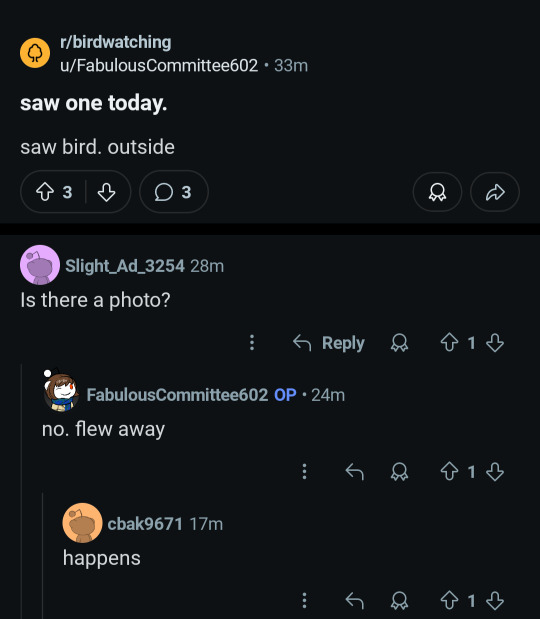Keep. 21. she/they/it. I like birds and botany. My gf has gotten me into jrpgs. I follow from keep-looking-here.tumblr.com Icon by rithalie-art.tumblr.com
Last active 60 minutes ago
Don't wanna be here? Send us removal request.
Text
if female top nudity weren't viewed as inherently sexually explicit. oh brother. I would be letting those puppies hang like you wouldn't believe
35K notes
·
View notes
Text

7 Days until the 20th Anniversary of Fire Emblem: Path of Radiance! I'll be posting illustrations that day! Also the 35th Anniversary of Fire Emblem in ... general!
85 notes
·
View notes
Text
Imagine Ignatz and Dorothea supports
That it. That’s the post
8 notes
·
View notes
Text
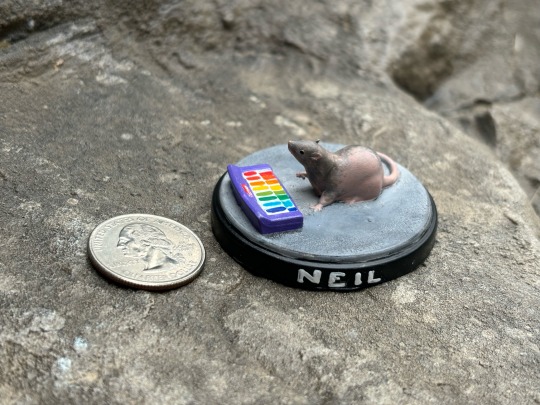
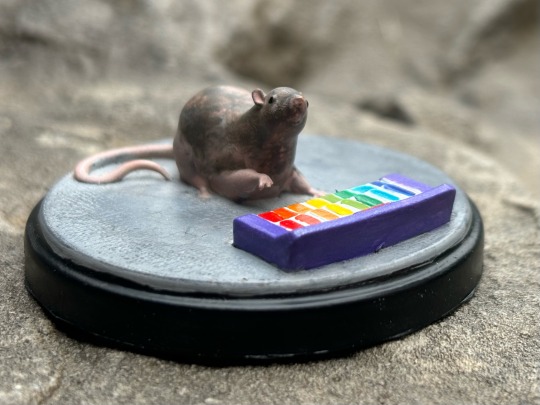
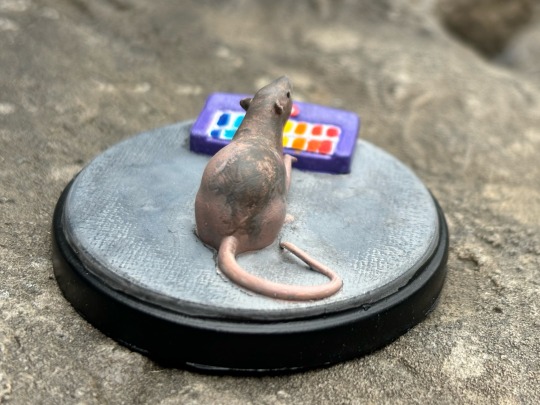
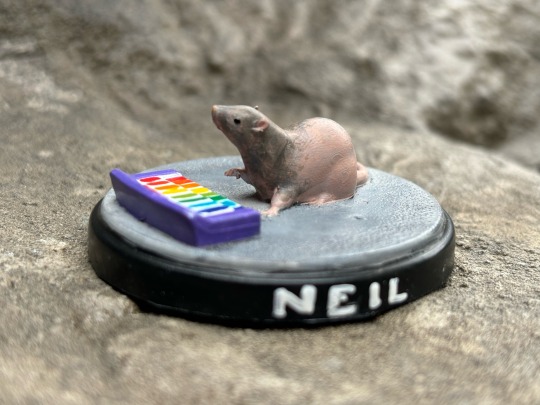
Happy Neil Banging out the Tunes day to all who celebrate!
I’ve gotten into resin printing and mini painting recently so I had to print out the little Neil model I made last year in honor of my favorite holiday
5K notes
·
View notes
Text
Fucked up that our emotional states affect other people. Like you’re already dealing with the massive indignity of having emotions in the first place and then on top of that it’s like “oh btw this other sentient being can tell that you’re annoyed and it negatively affects their well being!” disgusting. Absurd. Unconstitutional. Somebody needs to do something.
659 notes
·
View notes
Text
Round 3 - Reptilia - Podicipediformes




(Sources - 1, 2, 3, 4)
Our next order of birds are the Podicipediformes, commonly known as “grebes”. They are composed of one family, Podicipedidae, and 6 living genera containing 22 species.
Grebes are aquatic birds, though they do not have webbed feet, instead having lobes that come out the side of each toe. They cannot fly well, and they prefer to escape predators by diving under the water and swiftly swimming away. Their feet are set far back on their bodies, making them well suited for paddling and diving, but not for walking on land. Most species can not walk on land and spend their entire lives in the water. Grebes can be found on every continent except Antarctica, and usually reside in freshwater habitats during the warmer months, some migrating to marine habitats along the coast in the Winter. Those that can fly only do so at night to avoid being detected by predators. Most grebes eat aquatic invertebrates such as crayfish, while some larger grebes have long, spear-like bills adapted for catching and feeding on fish and amphibians.
Grebes are perhaps most famous for their elaborate courtship displays, which involve the pair performing synchronized duets and dances on the water’s surface. Some species do a "penguin dance" where the male and female stand upright, breast posturing out while they run along the water's surface, in a display of athleticism and agility (see gif below the read more). Some species perform a "weed dance" in which both partners hold pieces of aquatic vegetation in their bills. There is also the "weed rush" in which partners swim towards each other, necks stretched out with plants in their bill, and just before colliding position themselves upright and then swim in parallel. If the female decides the male has danced well, they will mate on floating vegetation. Females lay two to seven eggs on a floating nest, either at the water’s edge or anchored to reeds some distance from shore. If the parents have to leave the nest for a time, they will cover the eggs in weeds to hide them. Incubation can last nearly a month. Once the whole nest has hatched, the chicks climb on one of their parent's backs, as they do not quickly take to the water as well as waterfowl. Both parents take care of rearing their young. One parent usually dives for food while the other carries the young on the surface. After four weeks the chicks begin learning to swim, but will still return to their parents’ backs for safety.
Grebes belong to the clade Mirandornithes, which they share with flamingos. Basal members of Mirandornithes, such as Juncitarsus, existed in the Eocene before the two orders diverged, but it is not known when the split occurred as transitional grebe fossils are rare. True grebes do not appear in the fossil record until the Late Oligocene or Early Miocene, around 23–25 million years ago.
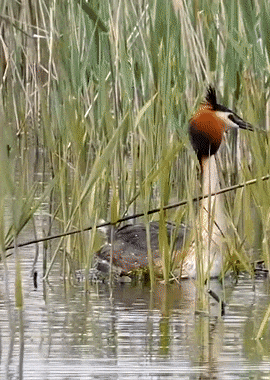
Propaganda under the cut:
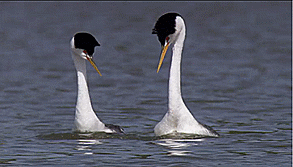

Some grebes eat their own feathers to aid in digestion, as the soft feathers will protect their digestive system from sharp fish bones and invertebrate exoskeletons, and also act as a filtering “plug” to hold bones in place until digestion. They will even feed feathers to their young.
Pied-billed Grebe (Podilymbus podiceps) (image 4) feathers were formerly used as decorations on hats and earmuffs, and they were hunted in the Eastern United States in the 19th century.
Ecologist Anne LaBastille documented the decline of the Atitlán Grebe (Podilymbus gigas) over a period of 25 years. The Atitlán Grebe was a large, flightless grebe that looked like a giant Pied-billed Grebe. The decline of the Atitlán Grebe began in 1958 after Smallmouth Bass (Micropterus dolomieu) and Largemouth Bass (Micropterus salmoides) were introduced into Lake Atitlán for fishermen to catch. These invasive species reduced the crabs and fish which the grebes depended on for food and killed grebe chicks. The population of the Atitlán Grebe declined from 200 individuals in 1960 to 80 in 1965. Anne LaBastille made efforts to establish a refuge in 1966, where the species was able to rebound. Unfortunately, after the 1976 Guatemala earthquake, the refuge’s lake bed fractured and began to drain. By 1983 only 32 individuals were left, many of which were hybrids with the Pied-billed Grebe. The last two birds were seen in 1989, and it was declared extinct by 1990. The same fate happened to the Colombian Grebe (Podiceps andinus) in 1977, and the Alaotra Grebe (Tachybaptus rufolavatus) of Madagascar in 2010, also due to the introduction of invasive fish and loss of habitat. Lake-dwelling grebes are especially vulnerable to extinction as they usually only live in one or a few lakes, and are not quickly able to disperse elsewhere.
The Least Grebe (Tachybaptus dominicus) is the smallest species of grebe, ranging from 21–27 cm (8.3–10.6 in) long and weighing 112–180 g (4.0–6.3 oz). They have a breeding call which has been compared to the sound of a horse whinnying.
Western Grebes (Aechmophorus occidentalis) have a “ticking” alarm call that is only used to signal to their chicks that danger is near. If on their parents’ backs, the chicks will hide their heads and go silent. If the chicks are old enough to be in the water, they may dive and swim away to hide.
The Horned Grebe (Podiceps auritus) (image 1) has 4 pair-bonding ceremonies: the discovery ceremony, the weed ceremony, the head-shaking ceremony, and the triumph ceremony. The discovery ceremony begins with advertising displays, which include an upright posture, erect "horns" and sounding their advertising call. Then, they will both engage in bouts of penguin dance and preening. The discovery ceremony is to ensure correct species identification, sex, and compatibility. The weed ceremony follows the completion of a successful discovery ceremony. The male and female will dive, retrieve weeds, and rise in synchronisation. The pair will come breast-to-breast with their weeds then turn side by side to continue swimming. The weed rush can continue multiple times until both individuals are satisfied. Finally, the head-shaking ceremony and triumph ceremony are performed for primarily established pairs.
The critically endangered Hooded Grebe (Podiceps gallardoi) is most threatened by the American Mink (Neogale vison), which was introduced to Argentina after the minks escaped or were released from fur farms. Between 2010 and 2011, when the minks were first introduced, they killed more than half the adults in a breeding colony of two dozen nests. Between 2012 and 2013, just one mink killed 15 adults and 7 juveniles at El Cervecero and 10 adults and 5 chicks at the C199 colony in La Siberia plateau. They are also threatened by the overgrazing of domestic sheep (which leads to erosion), territorial Flying Steamer Ducks (Tachyeres patachonicus), and predation by Kelp Gulls (Larus dominicanus).
Around 30% of grebe species are threatened, as they are shy birds particularly sensitive to human disturbance. Boats, even just the waves from them, may destroy floating grebe nests or scare the parents enough to cause them to abandon the nest. They are vulnerable to habitat loss, entanglement in fishing nets, and the introduction of invasive species such as predatory fish.
76 notes
·
View notes
Text
no matter who you are or where you live i recommend learning to id your local wildlife. like take pictures and post to inaturalist (people will help you id if you're not sure) it's genuinely fun as hell.
98 notes
·
View notes
Text
i go to the shop and I ask if they have any raspberries. they say no, they used to sell raspberries, but they haven't had any in stock in the last 15 years. I ask if there's somewhere else I can go to buy raspberries. They say no, with confidence and pride, they're the only shop around who has ever sold or will ever sell raspberries. Other shops might sell other fruit, sure, but they have a monopoly on all raspberries forever. I ask if they're possibly planning on them selling them again in future? they say they can't tell me that.
on the way home, I encounter someone eating raspberries. I ask and they tell me that they grow their own, they got some seeds from the shop back in The Raspberry Days and kept them. They take me to a field of many beautiful raspberry plants and invite me to pick my own, they're free for all the town to pick whenever they'd like.
someone comes up behind us. It's the shop manager, President of Nintendo Shuntaro Furukawa. he hatefully throws a bob-omb that blows up and kills both of us instantly for stealing 200 trillion dollars worth of potential Raspberry Shop That Doesn't Do Raspberries Anymore profits that they weren't making and then he turns around to the camera with a big thumbs up and says don't do piracy or something ok please
50K notes
·
View notes










